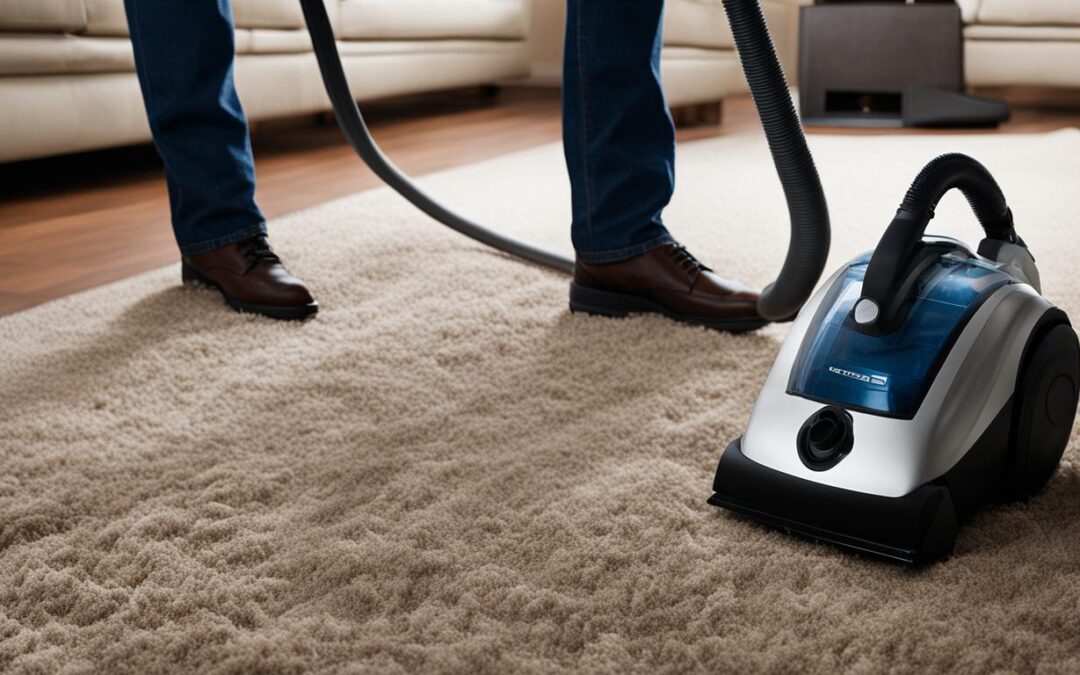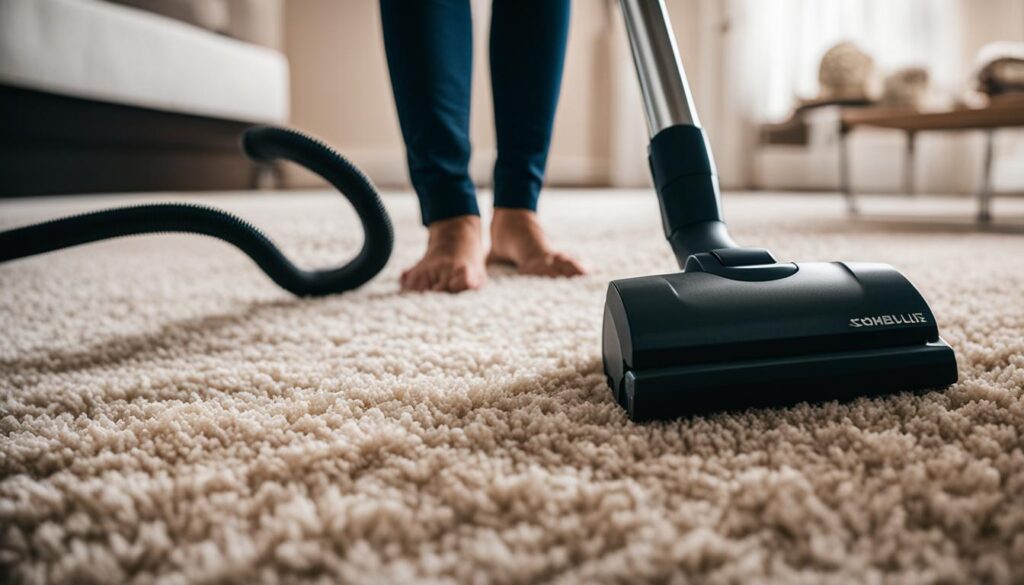If you want to keep your carpets looking fresh and clean for years to come, proper maintenance is crucial. From regular vacuuming to preventative measures, there are several steps you can take to maintain your carpets and extend their lifespan.
In this section, we’ll explore some essential carpet maintenance tips to help you keep your carpets in top condition. Whether you’re dealing with high traffic areas, stubborn stains, or unpleasant odors, we’ve got you covered with effective strategies and techniques.
Key Takeaways
- Regular vacuuming is essential for preventing dirt and debris from settling deep into the fibers of your carpets.
- Spot cleaning spills and stains promptly can prevent them from setting and becoming more difficult to remove.
- Deep cleaning your carpets, either DIY or with professional help, is necessary to remove embedded dirt and allergens.
- Preventive measures such as using furniture pads and avoiding wearing shoes indoors can help minimize wear and tear on your carpets.
- Developing a regular maintenance schedule for your carpets can help ensure they stay in excellent condition for years to come.
Regular Vacuuming
Regular vacuuming is an essential component of maintaining your carpets. Carpet fibers tend to trap dirt, dust, and debris, which can lead to discoloration and a shorter lifespan if left unattended. By vacuuming your carpets at least once a week, you can prevent dirt from accumulating and settling deep into the fibers.
When vacuuming, be sure to use the appropriate attachment for your carpet type and adjust the height so that it’s not too high or low. Going over areas multiple times from different directions can ensure that you’re effectively removing as much dirt as possible.
For high-traffic areas, such as hallways and entryways, consider vacuuming more frequently to prevent the buildup of dirt and debris. Regular vacuuming is one of the easiest and most effective ways to keep your carpets clean and well-maintained.
Spot Cleaning
Accidents happen, and when spills or stains occur on your carpets, it’s important to address them promptly to prevent long-term damage. Here are some effective carpet maintenance tips for tackling common carpet stains:
- Blot, don’t rub: When cleaning up a spill, avoid rubbing the affected area. Instead, gently blot the stain with a clean, damp cloth. Rubbing the stain can push it further into the fibers and make it harder to remove.
- Use a cleaning solution: For tougher stains, mix a solution of warm water and mild dish soap or white vinegar. Apply the solution directly to the stain and let it sit for 5-10 minutes before blotting with a clean cloth.
- Try baking soda: Sprinkle baking soda over the affected area and let it sit for a few hours before vacuuming it up. This can help absorb any leftover moisture and eliminate odors.
If you’re dealing with a particularly stubborn stain, it’s always best to consult with a professional carpet cleaning service to avoid causing damage to your carpets.
Deep Cleaning Methods
While regular vacuuming and spot cleaning are important, deep cleaning your carpets will remove embedded dirt, allergens, and odors, ultimately making your carpets last longer. Here are some DIY deep cleaning methods for carpets:
- Carpet Shampoo: Carpet shampoo is an effective way to deep clean your carpets. It is available in both powder and liquid form. Simply mix the shampoo with water, apply it to your carpets, and allow it to dry before vacuuming it up.
- Steam Cleaning: Steam cleaning is another popular method of deep cleaning carpets. It involves using a steam cleaner to inject hot steam into the carpet fibers, loosening dirt and grime. The moisture and dirt are then extracted with a powerful vacuum.
- Baking Soda: Baking soda helps to deodorize your carpets and remove stubborn stains. Simply sprinkle it over your carpets and let it sit for a few hours before vacuuming it up.
While DIY methods can save you money, professional carpet cleaning is also an option. A professional cleaning service can perform a deep clean using industrial-grade equipment and cleaning solutions. This is especially useful for high-traffic areas, tough stains, or if you’re unable to deep clean your carpets yourself.
Pros and Cons of DIY vs. Professional Carpet Cleaning
| DIY | Professional | |
|---|---|---|
| Cost | Low | High |
| Equipment | Less specialized | High quality and specialized |
| Results | Good for routine cleaning | Commercial-grade clean |
| Time and Effort | More time and effort | Less time and effort |
| Stain Removal | May not work on tough stains | Professional-grade products and methods |
| Drying Time | Longer | Shorter due to powerful equipment |
Choose the method that best meets your needs, schedule, and budget. Remember, regular deep cleaning is important to maintain the appearance and hygiene of your carpets.
Protecting High-Traffic Areas
If you have high-traffic areas in your home, such as hallways and entryways, your carpets are likely to accumulate more dirt, wear down faster, and require more maintenance. Protecting these areas can help extend the life of your carpets and save you money in the long run. Follow these carpet maintenance tips to keep high-traffic areas looking their best:
- Use entrance mats: Place entrance mats on both sides of your doors to prevent dirt and debris from being tracked onto your carpets. Clean the mats regularly to ensure they continue to absorb dirt and debris effectively.
- Implement a “no shoes” policy: Shoes can track in dirt and debris from the outdoors, so consider asking your family and guests to remove their shoes at the door.
- Rotate your furniture: Frequent movement of furniture can wear down carpet fibers and leave permanent indentations. Rotate your furniture occasionally to distribute weight evenly and prevent this type of wear and tear.
- Spot clean immediately: If spills occur in high-traffic areas, clean them up promptly to prevent stains from setting in. Refer to section 3 for effective spot cleaning techniques.
By taking these preventative measures, you can maintain the quality of your carpets and keep them looking new for longer.
Comparison of Entrance Mats:
| Entrance Mat Type | Pros | Cons |
|---|---|---|
| Coir Mats | Natural fiber material for eco-friendliness; effective at trapping dirt and debris. | May shed and require more maintenance; not as durable as some synthetic materials. |
| Rubber Mats | Easily washable and durable; non-slip surface for safety. | May not be as effective at trapping dirt and debris as some other materials; can crack over time in extreme temperatures. |
| Waterhog Mats | Excellent at trapping dirt and moisture; durable and long-lasting. | More expensive than some other entrance mat types. |
“Implementing a ‘no shoes’ policy at the door has made a significant difference in the state of our carpets. It’s amazing how much dirt and debris can accumulate from just a few steps in dirty shoes!” – Jane Smith, homeowner
Preventative Measures
Regular maintenance is essential to keep your carpets in top shape, but taking preventative measures can help minimize damage and prolong their life. Here are some ways to keep your carpets looking their best:
- Place doormats at entryways to prevent dirt and debris from getting tracked indoors.
- Remove your shoes when entering the house to minimize wear and tear.
- Trim your pets’ nails to avoid snags and scratches.
- Avoid placing plants or drinks near your carpets to prevent spills and stains.
- Rotate furniture to distribute weight and prevent dents and compression marks.
By taking simple preventative measures, you can protect your carpets and keep them looking like new for longer.
Proper Carpet Drying
After cleaning your carpets, it is important to ensure they are completely dry to prevent mold and mildew growth. Below are some useful tips for effective carpet drying:
- Avoid walking on the carpet: Walk as little as possible on the freshly cleaned carpet, since your shoes or feet may rub against the fibers, preventing the carpet from drying properly.
- Open windows and doors: Proper ventilation is essential for quick drying. Open doors and windows to allow air to circulate throughout the room.
- Use fans: Place fans in strategic locations around the room to increase airflow and speed up drying time.
- Try a dehumidifier: If the weather is particularly damp or humid, consider using a dehumidifier to remove excess moisture from the air.
- Don’t replace furniture: Do not replace furniture or other items on the carpet until it is completely dry, as this may cause irreversible damage to both the furniture and the carpet.
By following these simple tips, you can ensure that your carpets dry properly, preventing any potential mold or mildew problems.
Note: If you are unsure about the best way to dry your carpets or if drying time seems excessively long, consider consulting a professional carpet cleaner to help you avoid any potential problems or damage.
Odor Elimination
Carpets can add warmth and coziness to your home, but they can also trap unpleasant odors. Luckily, there are several tips and tricks to eliminate odors and keep your carpets smelling fresh.
- Start by identifying the source of the odor. Is it pet urine, cigarette smoke, or food spills?
- If it’s a fresh spill, blot it with a clean cloth to remove as much liquid as possible. Then, apply a carpet cleaner specifically designed for eliminating odors.
- For old, stubborn odors, sprinkle baking soda over the affected area and let it sit for a few hours. Vacuum up the baking soda and then use a mixture of white vinegar and water to clean the area.
- Hydrogen peroxide is another powerful odor eliminator. Mix it with water and apply it to the affected area, letting it sit for a few hours before vacuuming it up.
- Regularly shampooing your carpets can also help remove deep-seated odors. Use a carpet shampooer or hire a professional carpet cleaning service for best results.
By following these odor elimination tips and tricks, your carpets will stay clean and fresh-smelling.
Carpet Protection Tips
Keeping your carpets looking great doesn’t stop at cleaning. Protecting your carpets from damage is just as important. Whether you’re dealing with furniture dents, pet stains, or other hazards, here are some effective ways to protect your carpets:
Invest in Furniture Pads
Heavy furniture can leave unsightly dents in your carpets that don’t go away easily. To prevent this, consider investing in furniture pads that help distribute the weight of the furniture more evenly. Place these pads underneath the legs or corners of your furniture for added protection.
Use Rugs and Runners
High-traffic areas, such as hallways and entryways, are more prone to wear and tear than other parts of your home. To protect these areas, consider using rugs and runners. These not only provide added cushioning but also help prevent dirt and debris from getting ground into your carpets.
Treat Pet Stains Promptly
If you have pets, accidents are bound to happen. When they do, it’s essential to treat pet stains promptly. Use a cleaning solution specifically designed for pet stains and follow the manufacturer’s instructions carefully. Remember to blot, not rub, to avoid spreading the stain and causing damage.
| DIY Cleaning Solution for Pet Stains | Ingredients | Instructions |
|---|---|---|
| Vinegar-Baking Soda Mixture | White vinegar Baking soda Water |
|
Regularly groom your pets
Taking care of your pets’ grooming needs, such as regular brushing, can help prevent excessive shedding and minimize the amount of pet hair that accumulates on your carpets. This can make it easier to remove pet hair and debris when cleaning your carpets.
Place Doormats at Entrances
One of the most effective ways to minimize dirt and debris from entering your home is by using doormats at entrances. Placing mats both indoors and outdoors can help trap dirt and prevent it from being tracked onto your carpets.
By following these carpet protection tips, you can help prolong the life of your carpets and keep them looking great for years to come.
Regular Maintenance Schedule
Developing a regular maintenance schedule is key to keeping your carpets in excellent condition. By following a routine, you can avoid costly repairs and ensure that your carpets look and feel great for years to come.
Vacuuming frequency
Vacuuming your carpets is essential in preventing dirt buildup and prolonging their life. Aim to vacuum high-traffic areas at least once a day, while less busy areas once a week should suffice.
Spot cleaning
When dealing with stains and spills, it is critical to address them immediately to prevent them from setting in. Make sure to have a carpet cleaning solution on hand and tackle any mishap as soon as it occurs.
Deep cleaning
DIY deep cleaning solutions can be effective in removing tough stains and dirt. However, professional cleaning is recommended at least once every 6-12 months to ensure thorough cleaning and prevent damage to your carpets.
Preventive Measures
Preventive measures are a vital component in maintaining the condition of your carpets. Using entrance mats, removing shoes at the door, and avoiding eating in carpeted areas can help prevent stains and wear and tear.
Carpet Protection
Protect your carpets from damage caused by furniture by regularly checking and adjusting furniture to avoid indentations. If you have pets, make sure to trim their nails regularly and clean up any accidents immediately.
By following a regular maintenance schedule that includes vacuuming, spot cleaning, deep cleaning, and preventive measures, you can extend the life of your carpets and keep them looking and feeling great for longer. Remember to seek professional cleaning services when necessary and address any issues promptly to prevent damage or permanent staining.
Conclusion
Proper carpet maintenance is vital to keep your floors fresh, clean, and in excellent condition for years to come. A comprehensive carpet care routine includes regular vacuuming, spot cleaning, and deep cleaning. Don’t forget to take preventative measures to protect your carpets from damage and keep high-traffic areas looking their best.
Remember to ensure proper drying after cleaning your carpets to prevent mold and mildew growth. If you notice any unpleasant odors, use our tips and tricks to eliminate them and keep your carpets smelling fresh.
Follow our carpet maintenance tips and schedule regular maintenance tasks to keep your carpets pristine. With the right care, your carpets will continue to enhance the comfort and beauty of your home for years to come. So, start cleaning your carpets today and enjoy a fresh and clean living space!
FAQ
What are some essential carpet maintenance tips for homes?
Essential carpet maintenance tips for homes include regular vacuuming, spot cleaning, deep cleaning methods, protecting high-traffic areas, taking preventative measures, ensuring proper carpet drying, eliminating odors, and following a regular maintenance schedule.
Why is regular vacuuming important for carpet maintenance?
Regular vacuuming helps remove dirt, dust, and debris from the surface of your carpets, preventing them from settling deep into the fibers. It also helps maintain the overall cleanliness and longevity of your carpets.
How can I effectively spot clean my carpets?
To spot clean your carpets, promptly address spills or stains by blotting (not rubbing) the affected area with a clean cloth or paper towel. Use a mild carpet cleaner or a mixture of water and vinegar to gently clean the stain. Test any cleaning solution in an inconspicuous area first to ensure it doesn’t cause discoloration.
Should I hire a professional for deep cleaning my carpets?
While regular vacuuming and spot cleaning are important, deep cleaning your carpets periodically is recommended. Depending on your carpet’s condition, you may choose to DIY using carpet cleaning machines or hire a professional carpet cleaning service for a thorough and effective deep cleaning.
How can I protect high-traffic areas of my carpets?
To protect high-traffic areas, consider using rugs or mats in those locations. This helps minimize wear and tear on your carpets and provides an extra layer of protection against dirt and debris. Regular vacuuming in these areas is also essential.
What are some preventive measures I can take to maintain my carpets?
To prevent stains and minimize wear and tear, it’s advisable to implement a no-shoes policy indoors, use carpet runners in high-traffic areas, and promptly clean up any spills or accidents. You can also consider applying a carpet protectant product to create a barrier against stains and make cleaning easier.
How do I properly dry my carpets after cleaning?
After cleaning your carpets, ensure proper airflow and ventilation in the room to aid in drying. You can use fans or open windows to expedite the process. Avoid walking on the carpets until they are completely dry to prevent new dirt or damage.
How can I eliminate odors from my carpets?
To eliminate odors from carpets, sprinkle baking soda over the surface and let it sit for a few hours or overnight. Vacuum the baking soda thoroughly to remove the odors. You can also use carpet deodorizers or natural remedies like vinegar or lemon juice to combat unpleasant smells.
What are some carpet protection tips?
To protect your carpets, use furniture coasters or pads under heavy furniture to prevent indentations. Regularly trim your pet’s nails to avoid snags and scratches. Place entryway mats to trap dirt and moisture before it reaches the carpets. Additionally, avoid dragging or pulling heavy objects directly on the carpets.
How often should I perform carpet maintenance tasks?
Maintaining a regular schedule is important. It is typically recommended to vacuum high-traffic areas and general areas at least once a week, while other areas can be vacuumed once every two weeks. Spot cleaning should be done as soon as spills or stains occur, and deep cleaning can be done every 6-12 months, depending on foot traffic and household conditions.




